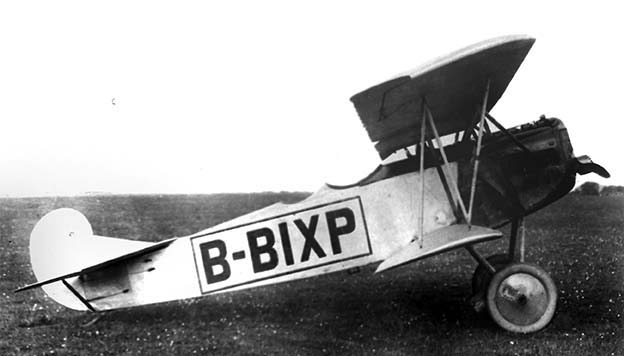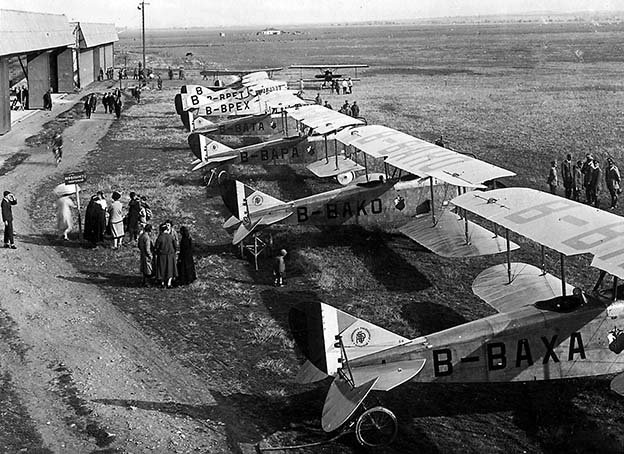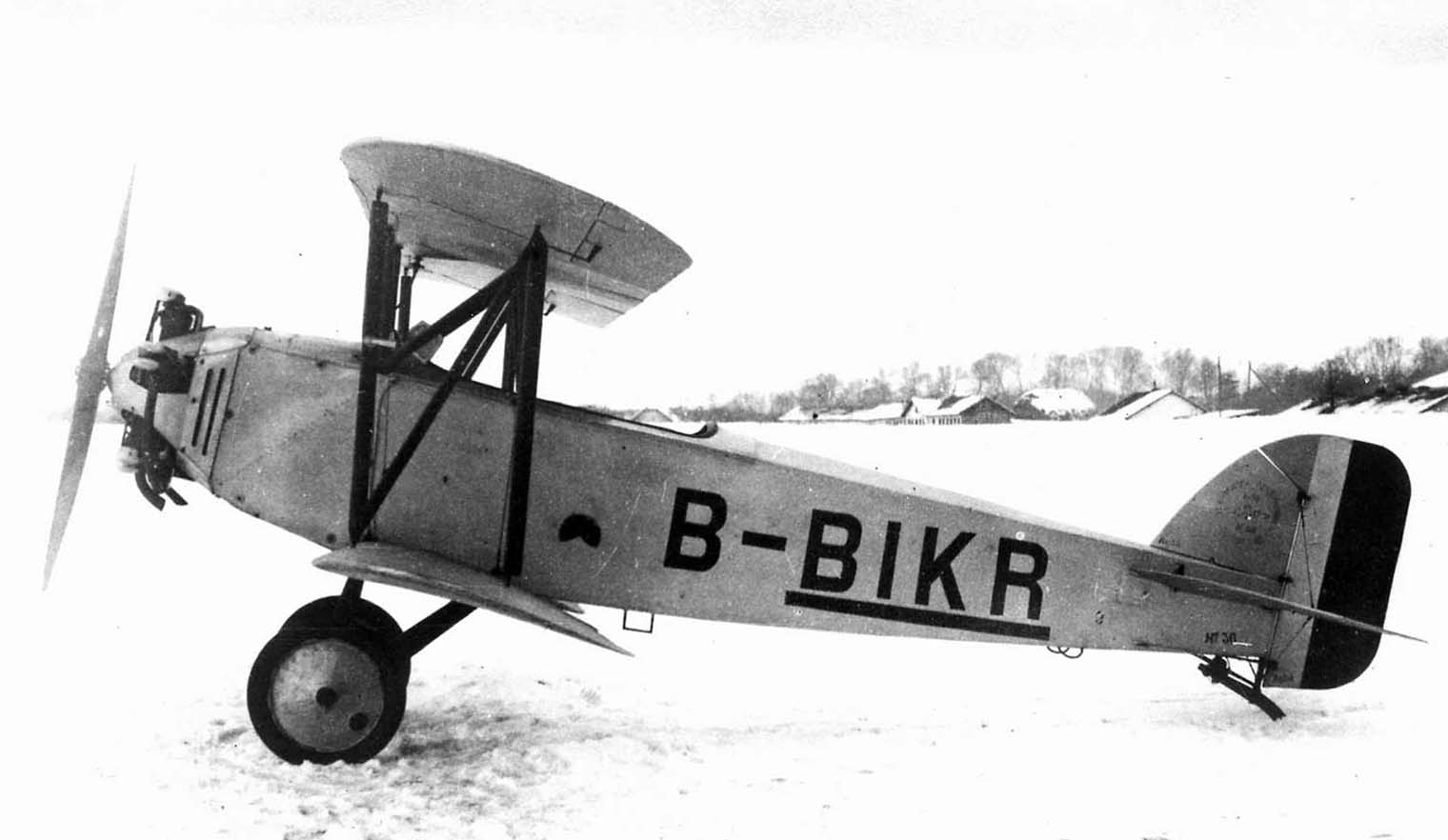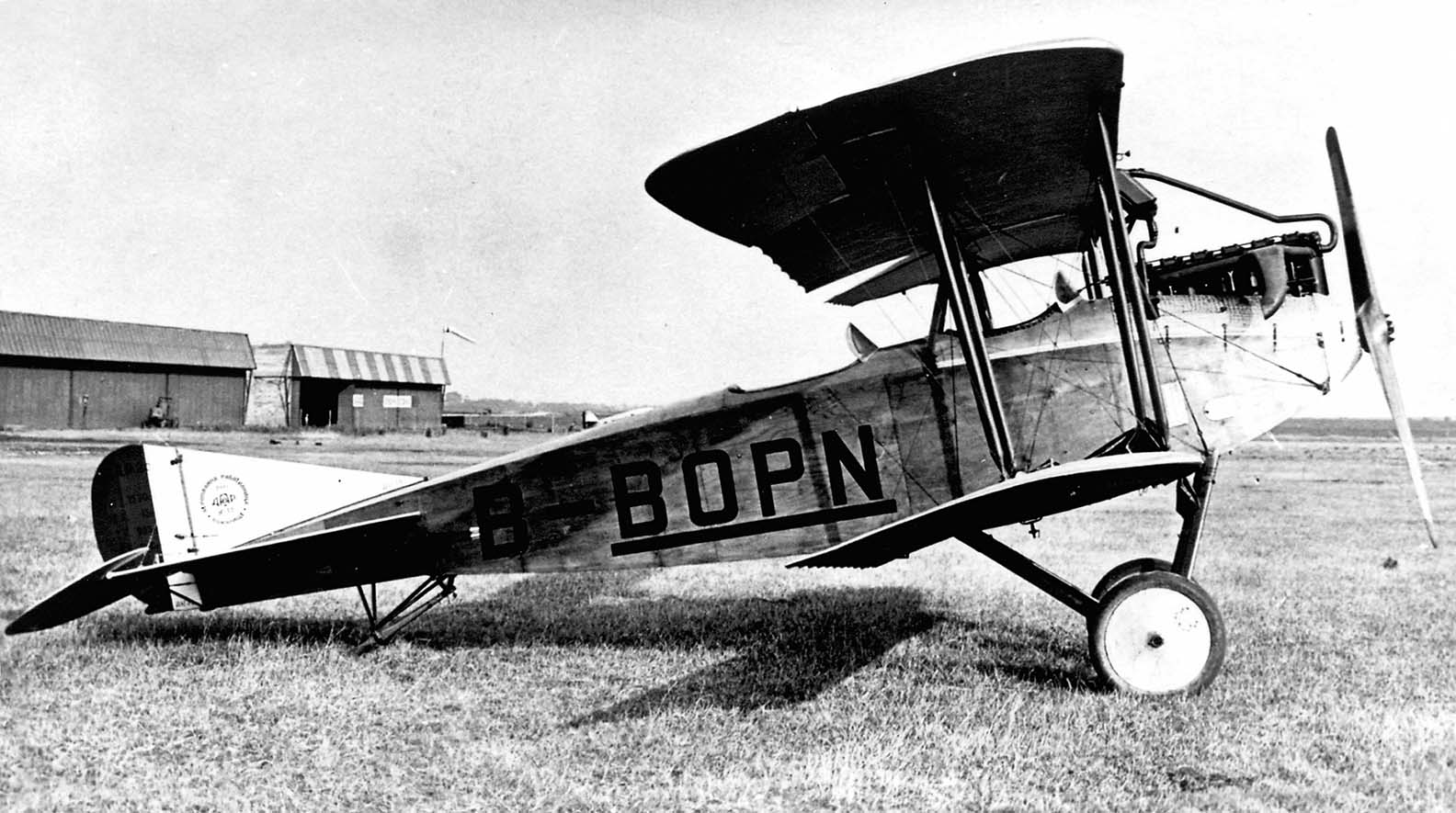On 4 October 1918 orders were issued for the demobilisation of the Bulgarian Army. The First World War was over and the Bulgarian Air Force, the
Vozdukhoplavatelna druzhina, was reorganised into just two small squadrons and a flying school that were all stationed at Buzhurishche outside Sofia, and a seaplane station at Varna. On 27 November 1919 the Bulgarian Government signed the Peace Treaty of Neuilly. The
Vozdukhoplavatelna druzhina was disbanded and a
Zhandarmeriisko aeroplanno otdelenie (Police Aviation Department) under the Ministry of War was set up instead, officially for customs and air police duties. It was commanded by Captain Ivan Milanov and remained stationed at Bozhurishte. However, this provoked strong French opposition and this unit had to be disbanded as well.
Two years later, on 27 October 1921, Colonel Arthur M Longmore, head of the Inter-Allied Aeronautical Commission of Control (IAACC) in Bulgaria, submitted the Commission's final execution report to the Inter-Allied Military Committee in Paris. The other members of the IAACC, which had operated between 21 August and 15 November 1920, had been French Lieutenant Colonel Ménard and Captain Poupon, Italian Major Coronati and Captains Lodi and Catanzare, Japanese Captain Fujie, and British Lieutenant Pilots Leslie and Daly.
 A DFW C.V with mixed German/Bulgarian markings.
A DFW C.V with mixed German/Bulgarian markings.
All personnel belonging to the Bulgarian Air Force was demobilised on 16 September 1921 and at that time there were ten officers, 17 non-commissioned officers and 68 soldiers. Bulgarian Naval Aviation was demobilised on 29 September. On 11 November the Bulgarian Government required to be allowed to keep five officers and 63 non-commissioned officers for the administration of the Buzhurishche aerodrome and this was approved on the following day but the authorization restricted personnel strength to five officers and 22 non-commissioned officers.
By 18 September all aircraft and engines had been assembled at Buzhurishche, including the floatplanes from Varna seaplane station, and were made unserviceable. All aircraft and engines, with the exception of 47 outdated low power French engines, were destroyed. The remains of the aircraft were inspected on 1 October and 9 November and were then sold as scrap. The profit was divided between France, Great Britain, Italy, Japan and Belgium. The following aircraft had been destroyed: 6 Fokker D.VIIs,
1 Fokker monoplane,
3 DFW C.Vs,
8 Albatros C.IIIs,
7 Rolands,
4 LVGs,
11 Ottos,
2 captured BE 2s,
1 captured Breguet fuselage,
5 Friedrichshafen FF 33s and
1 Rumpler 6B1.
The engines, including those not destroyed, were: four 200 hp Benz, 14 150 hp Benz, 23 160 hp Mercedes, five 100 hp Argus, 16 100-120 hp Mercedes, 32 50-70 hp Gnome, four 120 p Le Rhone, six 80 and 130 hp Renault, one 300 hp Renault, three Salmson, five 20-50 hp Anzani and six other engines of different types.
 Sofia's aerodrome at Bozhurishte.
Covert Operations
Sofia's aerodrome at Bozhurishte.
Covert Operations
The aerodrome at Buzhurishche was located 13 km northwest of Sofia on the road between the capital and Slirnitsa and there were four 45 x 25 metre hangars, but two of them were only partially completed. In addition there was a 50 x 30 metre repair workshop and two old wooden hangars. In addition, Varna seaplane station on the Black Sea had four small hangars. Bulgaria had been allowed to keep these buildings on the condition that no new aircraft were constructed there.
An Aeronautical Department (
Otdelenie za vozdukhoplavanie) was quietly created and Asen Yurdanov Agov was appointed director. In order emphasize its civil character it was placed under Ministry of Railways, Posts and Telegraphs (
Ministerstvoto na zheleznitsite, poshchite i telegrafite) and not under the Ministry of War. Parts from a number of aircraft, some sources say seven DFW C.Vs, Albatros D.IIIs and Fokker D.VIIs, had in fact been hidden at different places and had not been discovered by the IAACC. In addition Benz IV and Mercedes III engines and useable parts had been salvaged from aircraft destroyed by the IAACC and had been hidden as well. In 1921 these parts saw the light again and the first two "new" aircraft were assembled.
 An example of the Albatros C.III and a DFW C.Va, were assigned to the Bulgarian Otdelenie za vozdukhoplavanie in April 1922. This Albatros C.III was marked with serial number "2" on the fuselage.
An example of the Albatros C.III and a DFW C.Va, were assigned to the Bulgarian Otdelenie za vozdukhoplavanie in April 1922. This Albatros C.III was marked with serial number "2" on the fuselage.
By a special order these aircraft, an Albatros C.III and a DFW C.Va, were assigned to the
Otdelenie za vozdukhoplavanie on 10 April 1922 and some time later a 'reborn' Fokker D.VII joined them. It was fitted with a fake second cockpit in order to look a little more like a two-seat trainer than a fighter.
In March 1922 the Allies demanded that the
Otdelenie should be disbanded and in September German diplomats reported to Berlin that the Bulgarian Government was setting up a new state aviation service under the Ministry for Posts. The pilots were former officers who had officially left military service but were secretly still belonging to the Army. According to this report the
Otdelenie had two Albatros C.IIIs and a DFW C.Va was being assembled from parts. A photo of an Albatros C.III with s/n 2 seems to indicate that this report was possibly correct.
 Hanriot HD 14 "2" was one of the 14 French aircraft that were acquired by Bulgaria in 1923.
New Aircraft Acquired
Hanriot HD 14 "2" was one of the 14 French aircraft that were acquired by Bulgaria in 1923.
New Aircraft Acquired
Somewhat surprisingly, Bulgaria turned to its former enemies in the First World War, France and Great Britain, for new materiel for the secret air force that was being organised in defiance of the treaty it has signed in 1919. In August 1922 a tender for four aircraft intended for airmail transport had been called for. De Havilland and two German firms had replied, but their offers were not accepted. In February the Government approved the acquisition of 13 aircraft and a new tender for ten two-seaters and up to three five- to eight-seat aircraft was called for. The Germans reported that a total of 23 aircraft were being purchased and in Paris the Rumanian Legation protested to France and said that they were sure that the Bulgarian military were pulling the strings.
 In 1923 four Potez VIII trainers entered service at Bozhurishte, near Sofia.
In 1923 four Potez VIII trainers entered service at Bozhurishte, near Sofia.
It seems that political will to intervene was lacking, although when an order for training aircraft was placed in Germany, where aviation was strictly suppressed, Allied representatives reacted. On 25 April 1923 the Bulgarian Government had signed a contract with the Luftfahrzeug-Gesellschaft (LFG) for the delivery of seven two-seat LFG V 32 Bromberg trainers, but this order had to be cancelled.
In the meantime interest had centred on a British type, the Bristol 88 Tourer. This was a 'civil' version of the Bristol Fighter, which was normally powered by the 400 hp Jupiter engine. In order to conform to the technical restrictions imposed on Bulgarian aviation it had been fitted with an engine of lower output. Engines over 200 hp were not permitted and therefore Bulgaria was offered a version of the Tourer with the 180 hp Wolseley Viper. An order for three aircraft of this type was negotiated and initially discussions also involved three examples of the four-engine passenger transport Bristol Pullman.
 An example of the Fokker D.VII reappeared and received a civil registration.
An example of the Fokker D.VII reappeared and received a civil registration.
In September 1923 orders were finally placed for three Bristol Tourers and two Avro 552 floatplanes. The Avro 552 was a floatplane variant of the two-seat Avro 504K that was fitted with the same Wolseley Viper engine that powered the Bristol Tourer. The five Bristol and Avro aircraft were ready for delivery in December, but the necessary certificate that they were in agreement with the technical restrictions were delayed.
In the meantime orders had been placed in France for a total of six Caudron C.59s, four Hanriot HD 14s and four Potez VIIIs. All were training aircraft, although the C.59 could be used for observation as well. These aircraft probably arrived in December 1923 and on the 15th of that month a flying school, the
Aeroplannoto uchilishche, was opened at Buzhurishche. The Hanriot HD 14 model 1923 was a two-seat trainer powered by the 80 hp Le Rhone and the diminutive Potez VIII, fitted with a 60 p Anzani, was a two-seater as well.
 In September 1923 an order for three Bristol Tourers, a variant of the Bristol Fighter, was placed by the Bulgarian Government. They were delivered in 1924.
Military Markings
In September 1923 an order for three Bristol Tourers, a variant of the Bristol Fighter, was placed by the Bulgarian Government. They were delivered in 1924.
Military Markings
At the beginning of July 1923 Bulgaria acceded to the International Air Traffic Convention and on 20 October 1923 the ban on construction, import and export of aviation materiel had been lifted, but military aviation was still strictly prohibited. Just like the Albatros C.III, DFW C.Va and Fokker D.VII, the new French aircraft were first painted as military aircraft with national insignia in the form of white/green/red roundels on the wings and vertical white/green/red stripes on the rudder. In addition they received serial numbers: 1 to 6 for the Caudrons, 1 to 4 for the Hanriots, and 1 to 4 for the Potez VIIIs. Bulgaria had been allocated marks of the form B-Bxxx for civil aircraft and when a civil aircraft register was introduced early in 1924 all aircraft at Bozhurishte received civil registration marks, which replaced the military-style numbers and insignia.
 A Potez VIII trainer with military type markings (white/green/red roundels).
A Potez VIII trainer with military type markings (white/green/red roundels).
Early in February 1924 the necessary certificates were issued and the Avro floatplanes, B-BAHA and B-BBAH, and the Bristol Tourers, B-BECA, B-BEHA and B-BEPA (c/ns 6383 to 6385), could be sent to Bulgaria. The last-mentioned Tourer was of a slightly different configuration than the other two. On18 August Stefan Pampulov crashed to his death when test flying one of the Avro floatplanes at Burgas on the Black Sea. By then another floatplane was available. A Friedrichshafen FF 33E that had 'reappeared' had been assembled by a mechanic named Atanas Grigorov at Buzhurishche and had been sent to Varna. It was powered by the 150 hp Mercedes D.III. By April 1924 it had made several successful flights, but it was soon destroyed in a severe storm. It was named Leitenant Lyapchev.
In 1924 the following aircraft were at Buzhurishche and received civil registrations:
Fokker D.VII, B-BIXP
Caudron C.59s, B-BACO, B-BETA, B-BETR, B-BYTO and B-BYTR (one had probably been written off)
Hanriot HD 14s, B-BILO, B-BONO and B-BRAT (one probably written off)*
Potez VIIIs, B-BETE, B-BLEN, B-BODR and B-BUEN
Bristol 88 Tourers, B-BECA, B-BEHA and B-BEPA
 The first three Bristol Tourers of six acquired were registered B-BECA, B-BEHA and B-BEPA.
Acquisitions From Abroad
The first three Bristol Tourers of six acquired were registered B-BECA, B-BEHA and B-BEPA.
Acquisitions From Abroad
In 1926 not less than 22 new aircraft were acquired from abroad. Bristol delivered one example of the Bristol 83 Trainer, B-BEPK (c/n 6936), and three improved Bristol 88A Tourers, B-BEBA, B-BETO and B-BEKA (c/ns 6937, 6939 and 6938). Six Bristol Trainers had been offered already in October 1924 but only one was ordered and delivered in April 1926. This was a two-seat aircraft powered by the 120 hp Lucifer IV that was intended for primary training. The Type 88A had a larger fin than the Type 88 and a new type of radiator and the three aircraft were delivered in April or May 1926. In addition ten Letov S.18 two-seat trainers arrived from Czechoslovakia: B-BIBO, B-BIHO, B-BIKO, B-BIPO, B-BITO, B-BIXO, B-BILA, B-BIDA, B-BISA and B-BITA.
 In 1926 Bristol delivered one example of the Bristol 83 Trainer, which was registered B-BEPK.
In 1926 Bristol delivered one example of the Bristol 83 Trainer, which was registered B-BEPK.
 In September 1923 two Avro 552 floatplanes were ordered. They were variants of the two-seat Avro 504K trainer.
In September 1923 two Avro 552 floatplanes were ordered. They were variants of the two-seat Avro 504K trainer.
 In 1926 ten Letov S.18 trainers arrived from Czechoslovakia.
In 1926 ten Letov S.18 trainers arrived from Czechoslovakia.
Two Macchi M.18 flying baots, B-BPAM (c/n 3595) and B-BPAK (registration not confirmed) were bought in Italy and finally France delivered six examples of the Potez XVII A2, B-BPEC, B-BPEH, B-BPEK, B-BPEM, B-BPET and B-BPEX (c/ns 1-6). Surprisingly this was a two-seat reconnaissance type powered by the 400 hp Lorraine Dietrich. It was clearly a military type, although the Bulgarians stated that it had been acquired for an airmail service.
In the meantime the
Otdelenieto za vozdukhoplavanie had been renamed the
Direktsiya na vozdukhoplavaneto (Aeronautical Direction) on 15 July 1924. This changed nothing and training of new pilots and observers continued on the civil-registered aircraft. The workshops at Buzhurishche did not just repair and rebuild aircraft but had started to built the first Bulgarian glider and in 1925 they were reorganised as the
Darzhavna aeroplanna rabotilnitsa - DAR (State Aeroplane Workshop) and a group of German specialists were invited in July 1925 to design and build new aircraft. The German design team was headed by Herman Winter and included engineers Otto Nussbaum and Weissbricht, and artisans Adolf Konrad, Josef Stempel and Schulze.
 Two Macchi M.18 flying boats, including B-BPAM, were obtained in Italy.
Domestic Aircraft Production
Two Macchi M.18 flying boats, including B-BPAM, were obtained in Italy.
Domestic Aircraft Production
The first type designed was in fact a copy of the old DFW C.Va. It was called the Uzunov U-1 and on 16 November 1925 the first example performed its first flight with Marko Parvanov at the controls. A total of seven were built by DAR and were delivered in 1926: B-BACA, B-BAPA, B-BATA, B-BAKO, B-BATO, B-BAXA and B-BATE (c/ns 1-7). They were powered by 220 hp Benz IV engines that had been either hidden in 1920 or imported from Germany.
 The DAR U-1 was a copy of the DFW C.Va and seven were built and were delivered in 1926.
The DAR U-1 was a copy of the DFW C.Va and seven were built and were delivered in 1926.
Bulgarian economy suffered of the same decline as in Germany and many other countries in the early 1920 and inflation was severe. Still, published statistics show a constant growth in the budget for aviation:
1922-23 5,693,000 Leva
1923-24 9,468,000 Leva
1924-25 23,243,000 Leva
1925-26 77,849,000 Leva
1926-27 32,880,000 Leva
From 1925 much of the budget was reserved for indigenous production by DAR and in 1926 two Zdravka gliders designed by Herman Winter (probably c/ns 8-9) that were named
Toprakchiev and
Vekilski were completed. Production then continued with twelve examples of a primary trainer designated DAR-1 and powered by a 60 hp Walter NZ engine: B-BIKE, B-BIKA, B-BIKB*, B-BIKC, B-BIKD, B-BIKF, B-BIKH, B-BIKK, B-BIKL, B-BIKN, B-BIKM and possibly B-BIKI* (c/ns 10-21). A second batch of 18 of this type but with a more powerful engine were built in 1928.
 DAR-1 B-BIKK was delivered in 1926. Twelve examples of this type were built.
DAR-1 B-BIKK was delivered in 1926. Twelve examples of this type were built.
In 1926-27 a copy of the Albatros C.III, the DAR-2, fitted with 160 hp Mercedes D.III engines, were completed: B-BOPA, B-BOPB, B-BOPC, B-BOPD, B-BOPE, B-BOPF, B-BOPI, B-BOPK, B-BOPL, B-BOPM, B-BOPN and B-BAPO (c/ns 22-33).
On 31 March 1927 a protocol was signed in Paris with the Bulgarian Government to the effect that no military or naval aviation was permitted, but sports and civil aviation within the boundaries of 'normal progress' was permitted. This was immediately taken advantage of and with all the new aircraft available three disguised operational military units were soon set up: the
sportno yato (Sports Squadron) with the Fokker D.VII, the Bristol Trainer and four DAR-1s, the
transportno yato (Transport Squadron) with six U-1s, and the
poshchensko yato (Postal Squadron) with six Potez XVIIs. In reality these were the Bulgarian Air Force's first fighter, bomber and reconnaissance units. Few actual airmail flights were performed and most flights were probably part of the pilot and observer training schedule.
 A second batch of 18 of DAR-1As with a more powerful engine were built in 1928.
Summing Up
A second batch of 18 of DAR-1As with a more powerful engine were built in 1928.
Summing Up
In 1927 a 'Final Operations' Report' on the carrying out of the Neuilly Peace Treaty regulations in Bulgaria was prepared. It stated that when the IAACC left Bulgaria at the end of November 1920, all aviation assets had been liquidated. A search performed in June 1922 revealed, however, an 'Albatros D.7' that had been hidden from the IAACC, and in 1925 and 1926, engines and spare parts had reappeared. This was mentioned without any further comments and it was also noted that some of the aircraft destroyed by the IAACC had been rebuilt: a 150 hp Brandenburg and a 150 hp Friedrichshafen. The 'Albatros D.7' was of course the Fokker D.VII and the Brandenburg was likely another mistake.
 DAR-2 B-BOPD. This type was a copy of the Albatros C.III.
DAR-2 B-BOPD. This type was a copy of the Albatros C.III.
Taking advantage of the rights awarded to the Bulgarian Government in October 1923 a state-owned aviation service had been established that was officially intended only for airmail and passenger transport. On 31 March 1927 stock had been taken and the Direktsiya na vozdukhoplavaneto was found to have 40 aircraft on its inventory, which had all been certified and approved. The personnel employed were former Air Force officers and a substantial number of new pilots were being trained. On 31 March there were 35 pilots and 31 students, but it was noted in the report that it was probable that some trained pilots were not on the official lists. Aerodromes existed at Bozhurishte, Filippopoli (Plovdiv), Penardzhik/Varna (hydro), Gorna Oryakhovitsa, Yambol and Razlog, emergency landing fields Ikhtiman and Harmanli.
 B-BOPN was one of the twelve DAR-2s that were delivered in 1926-27.
B-BOPN was one of the twelve DAR-2s that were delivered in 1926-27.
Bulgarian
Direktsiya na vozdukhoplavaneto aircraft inventory, 31 March 1927
1 Fokker D.VII (200 hp Mercedes)
5 Caudron C.59 (140 hp Mercedes or 200 hp Hispano Suiza)
1 Hanriot (80 hp Le Rhone)
3 Potez VIII (70 hp Anzani)
3 Bristol Tourer (180 hp Viper)
1 Avro (210 hp Viper)
1 Bristol 83 (120 hp Lucifer)
3 Bristol 88A (180 hp Viper)
6 Potez XVII (400 hp Lorraine Dietrich)
8 Smolik S.18 (60 hp Walter)
1 Macchi (250 hp Isotta Fraschini)
7 U-1 (200 hp Benz)
Two of the Caudrons and one Tourer were unserviceable but could be repaired.
 A "Postal Squadron" was set up with the Potez XVII (left) in 1927. In reality it was the Bulgarian Air Force's first military reconnaissance unit.
A "Postal Squadron" was set up with the Potez XVII (left) in 1927. In reality it was the Bulgarian Air Force's first military reconnaissance unit.
List of Bulgarian pilots, 31 March 1927;
Bandev, V,
Chichkov, D,
Chirpanliev, P,
Davov, S,
Dimitrov, M,
Dzhigalov, I,
Georgiev, A,
Ionov, I,
Ivanov, S,
Kantardzhiev, B,
Karakchiev, Jordan,
Lazarov, Kh,
Marinov, I,
Mateev, M,
Menov, M,
Minev, M,
Monov, T,
Nikolov, L,
Noyarev, I,
Nulev, V,
Ozunski, I,
Papchrestev, P,
Papvasiliev, G,
Parvanov, M,
Petkov, N,
Poichev, P,
Rachev, A,
Rogev, T,
Semenov, Jordan,
Slavov, S,
Stoikov, Kh,
Tomov, B,
Travatinov, B and
Zhechakov, I





